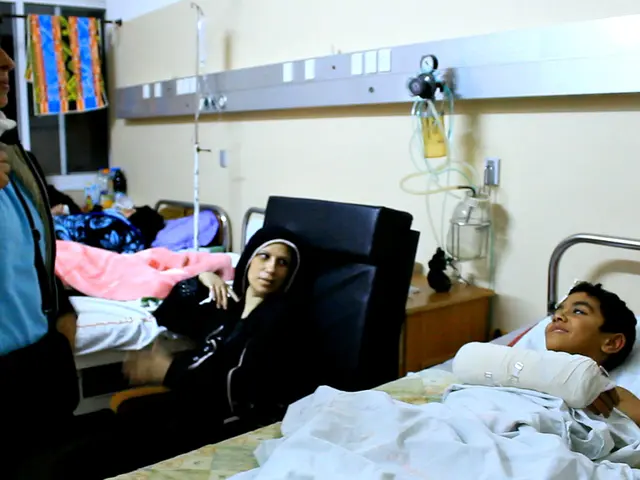Graft-versus-host disorder (GVHD): An understanding of GVHD
Stem Cell Transplants and Potential Risks:
Undergoing a stem cell transplant can be a lifesaver for people battling certain types of cancer. However, there's a potential complication known as graft-versus-host disease (GVHD) that can occur when the donor cells view the recipient's healthy cells as foreign and attack them.
An allogeneic transplant involves using cells from a cancer-free donor who matches the recipient's tissue type. These cells replace the ones that were destroyed during chemo or radiation, and they contribute to the much-coveted "graft-versus-cancer effect," where the donor's stem cells may attack any cancer cells found in the recipient.
However, this same attack can lead to GVHD. In essence, the donor T cells that are part of the immune system don't recognize the host's healthy cells, leading to a range of health issues.
There are several factors that can increase the risk of GVHD. Tissue mismatch between donor and recipient, for example, can make the recipient more susceptible. Other risk factors may include age, use of peripheral stem cells, transplants from unrelated donors, and cytomegalovirus (CMV) infection in either the donor or recipient.
GVHD: A Serious Condition:
GVHD is a severe and potentially life-threatening condition. It has two main forms: acute and chronic.
Acute GVHD typically appears within the first 100 days following an allogeneic stem cell transplant, and it can occur within the first 2-3 weeks. The new bone marrow begins to make new blood cells, and the donor's immune cells start attacking the recipient's healthy cells. Symptoms can include skin rashes, diarrhea, stomach cramps, and yellowing of the skin or whites of the eyes.
Chronic GVHD most commonly occurs in people who have experienced acute GVHD and can last longer and be more debilitating. Chronic GVHD can lead to skin problems and hair loss, as well as damage to organs such as the lungs and liver.
Managing GVHD:
Healthcare professionals employ medications to suppress the immune system or anti-inflammatory drugs, like steroids, to manage GVHD. The choice depends on whether the condition is acute or chronic. Both acute and chronic GVHD cases can require treatment for up to a year or more.
Supportive care is crucial in managing GVHD symptoms, such as adjusting the diet for people with chronic GVHD involving the gut. In some cases, special procedures like extracorporeal photopheresis or infusions of mesenchymal stem cells may be used.
While manifold treatment options are available, monitoring the progression of GVHD is vital, and regular check-ups with healthcare professionals are necessary to adjust treatment plans as needed.
Prognosis of GVHD:
The outlook for people with GVHD varies and is impacted by numerous factors such as the severity of disease, when it was detected, and the response to treatment. Now, more than 2 in 3 people with severe GVHD can survive 2 years after the onset of the disease due to better treatment methods and care practices.
One major concern is that chronic GVHD may last a lifetime, causing damage to lungs, liver, and other organs. With proper treatment, however, many cases of both acute and chronic GVHD can be successfully managed.
Enrichment Data:
Acute and chronic graft-versus-host disease (GVHD) are complications that can occur after a bone marrow or stem cell transplant when the donated cells (graft) attack the recipient's (host's) body. They differ mainly in timing, symptoms, and clinical manifestations.
- Common Symptoms:
- Acute GVHD: Skin rash, itching, red skin areas, jaundice (yellowing of skin and eyes), gastrointestinal symptoms such as abdominal pain, loss of appetite, diarrhea, nausea, and vomiting. Intestinal involvement may result in anorexia, weight loss, prolonged nausea, and frequent vomiting.
- Chronic GVHD: Painful mouth sores, persistent diarrhea, gut discomfort, and problems with eating and digestion. Dietary adjustments may be needed due to gut sensitivity.
- Types of GVHD:
- Acute GVHD: Early after transplant, primarily affecting the skin, liver, and gastrointestinal tract.
- Chronic GVHD: Appears later and can affect many organs including skin, eyes, mouth, liver, lungs, and the gastrointestinal tract, often resembling autoimmune disorders.
- Causes and Risk Factors:
- GVHD is caused by immune cells from the donor attacking the host tissues after transplantation.
- Factors increasing the risk include older age of recipient or donor, tissue mismatch between donor and recipient, use of peripheral stem cells for transplant, transplants from unrelated donors, female donors with multiple pregnancies, cytomegalovirus infection in donor or recipient, and age.
- Treatment:
- Diagnosis involves clinical examination, blood tests (for infection, liver function), and biopsies of skin, liver, or intestine to confirm GVHD.
- Treatment aims to suppress the donor immune cells attacking the body and manage symptoms. Immunosuppressant medications, antibiotics, symptom management medicines, and dietary modification may be employed. Special procedures like extracorporeal photopheresis, infusions of mesenchymal stem cells, or other medications may also be used.
- In the realm of science, stem cell transplants offer hope for individuals dealing with certain types of cancer.
- The process involves the use of cancer-free donor cells that match the recipient's tissue type, serving to replace destroyed cells and contributing to the 'graft-versus-cancer effect'.
- This effect, however, can lead to graft-versus-host disease (GVHD), where donor T cells attack the recipient's healthy cells.
- Risk factors for GVHD include tissue mismatch, age, use of peripheral stem cells, transplants from unrelated donors, and cytomegalovirus (CMV) infection.
- GVHD has two main forms: acute and chronic, each with distinct symptoms and timings.
- Acute GVHD typically appears within the first 100 days, showing symptoms like skin rashes, diarrhea, and stomach cramps.
- Chronic GVHD, which can last longer and be more debilitating, may cause skin problems, hair loss, and damage to organs such as the lungs and liver.
- Healthcare professionals manage GVHD using medications to suppress the immune system or anti-inflammatory drugs.
- Treatment may involve dietary adjustments, special procedures like extracorporeal photopheresis, or infusions of mesenchymal stem cells.
- Monitoring the progression of GVHD and having regular check-ups with healthcare professionals is crucial.
- The prognosis of GVHD varies, but now more than 2 in 3 people with severe GVHD can survive 2 years with better treatment methods and care practices.
- Other health-related topics such as workplace wellness, mental health, sexual health, men's health, women's health, parenting, weight management, nutrition, aging, skin care, neurological disorders, cbd, Medicare, and therapies and treatments also play vital roles in maintaining overall health and wellness.








